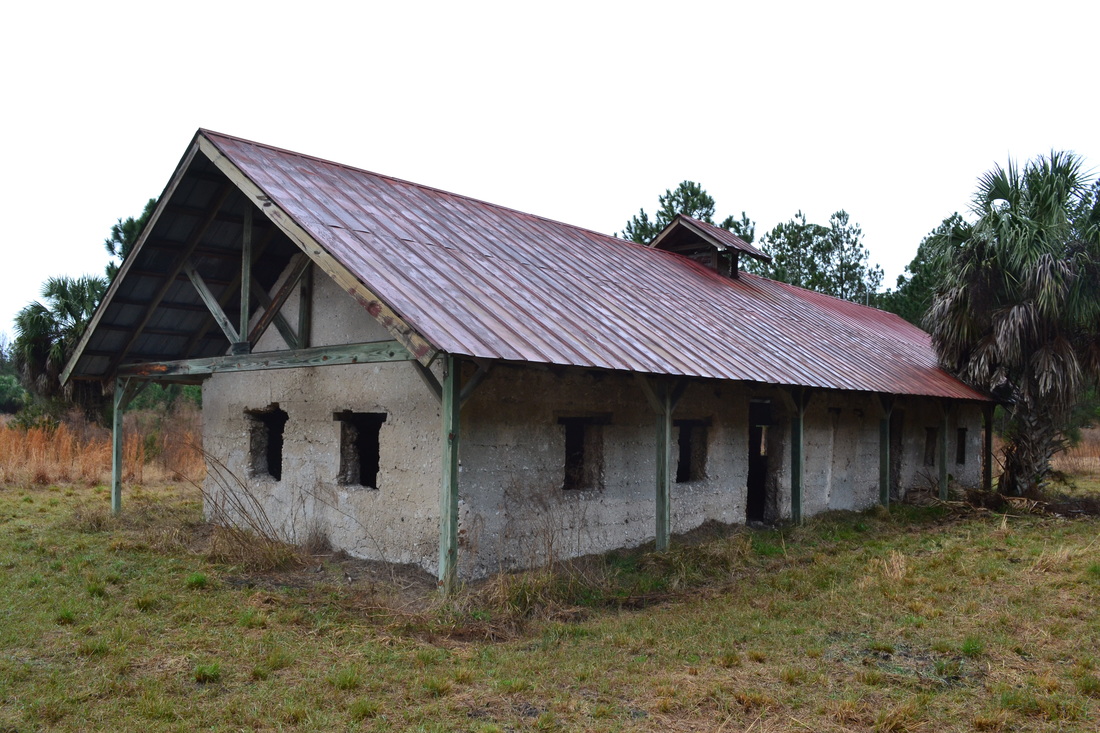Description
Antebellum tabby buildings are used by researchers on St. Catherines Island, which is closed to the general public. A tabby slave cabin serves as a guest house, and a tabby barn holds equipment. Another tabby building was once a church for freed slaves.
History
St. Catherines, located off the coast of Georgia, was an important center for the Guale Indians. Spanish missionaries converted natives on the island and constructed the Mission Santa Catalina de Guale in the late 1500s. The mission was abandoned in the late 1600s after the arrival of the British, and this site of North America's oldest Catholic Church disappeared until archaeologists from the American Museum of Natural History found it in the late 1970s.
The island became part of the Georgia colony and was given to Mary Musgrove, the Indian princess who served as translator for the English. Musgrove and her husband Thomas Bosomworth established a plantation once slavery became legal in Georgia in 1749. After her death, the island was sold to Button Gwinnett, signer of the Declaration of Independence, and the Antebellum structures on the north end of the island (the location of today's compound for researchers) are believed to date from his time. The Waldburg family came to own the entire island until the Civil War.
For a brief time after the Civil War, St. Catherines came under the control of the Freedman's Bureau and was run by Tunis Campbell, until the federal government forced the ex-slaves to leave. The former slaves turned a tabby building on the south end of the island into a church. The island had various owners until 1943 when Edward Noble purchased it. The Noble family has turned the island over to the St. Catherines Island Foundation, which today supervises research programs on the island. For more information, visit St. Catherines Island Foundation website.
Location
GPS: N 31°40.143, W 81°09.492 (St. Catherines Dock and Compound, on the north end of the island)
Address: The island can only be reached by boat. Boats typically depart from Halfmoon Marina, located at 171 Azalea Rd., Midway GA 31320.
Accessibility: Closed to the public
Antebellum tabby buildings are used by researchers on St. Catherines Island, which is closed to the general public. A tabby slave cabin serves as a guest house, and a tabby barn holds equipment. Another tabby building was once a church for freed slaves.
History
St. Catherines, located off the coast of Georgia, was an important center for the Guale Indians. Spanish missionaries converted natives on the island and constructed the Mission Santa Catalina de Guale in the late 1500s. The mission was abandoned in the late 1600s after the arrival of the British, and this site of North America's oldest Catholic Church disappeared until archaeologists from the American Museum of Natural History found it in the late 1970s.
The island became part of the Georgia colony and was given to Mary Musgrove, the Indian princess who served as translator for the English. Musgrove and her husband Thomas Bosomworth established a plantation once slavery became legal in Georgia in 1749. After her death, the island was sold to Button Gwinnett, signer of the Declaration of Independence, and the Antebellum structures on the north end of the island (the location of today's compound for researchers) are believed to date from his time. The Waldburg family came to own the entire island until the Civil War.
For a brief time after the Civil War, St. Catherines came under the control of the Freedman's Bureau and was run by Tunis Campbell, until the federal government forced the ex-slaves to leave. The former slaves turned a tabby building on the south end of the island into a church. The island had various owners until 1943 when Edward Noble purchased it. The Noble family has turned the island over to the St. Catherines Island Foundation, which today supervises research programs on the island. For more information, visit St. Catherines Island Foundation website.
Location
GPS: N 31°40.143, W 81°09.492 (St. Catherines Dock and Compound, on the north end of the island)
Address: The island can only be reached by boat. Boats typically depart from Halfmoon Marina, located at 171 Azalea Rd., Midway GA 31320.
Accessibility: Closed to the public


 RSS Feed
RSS Feed
